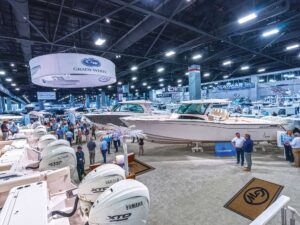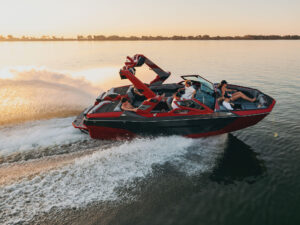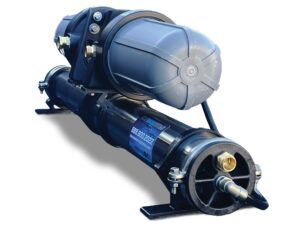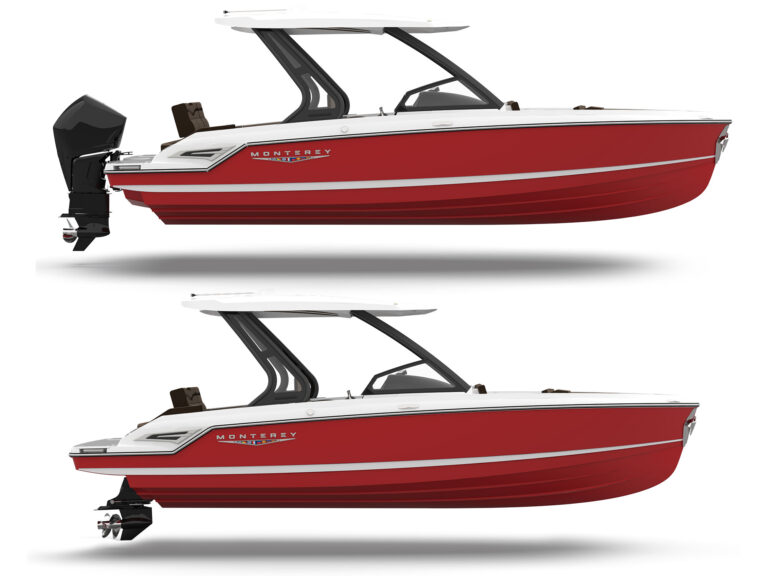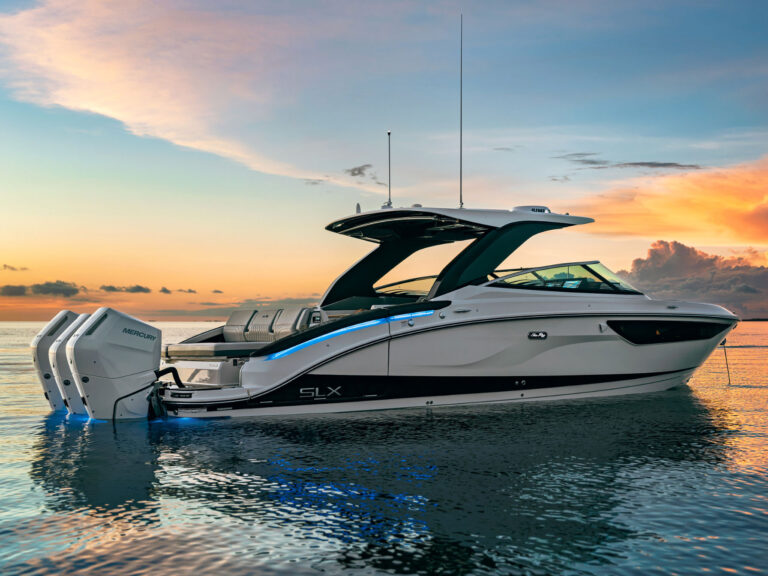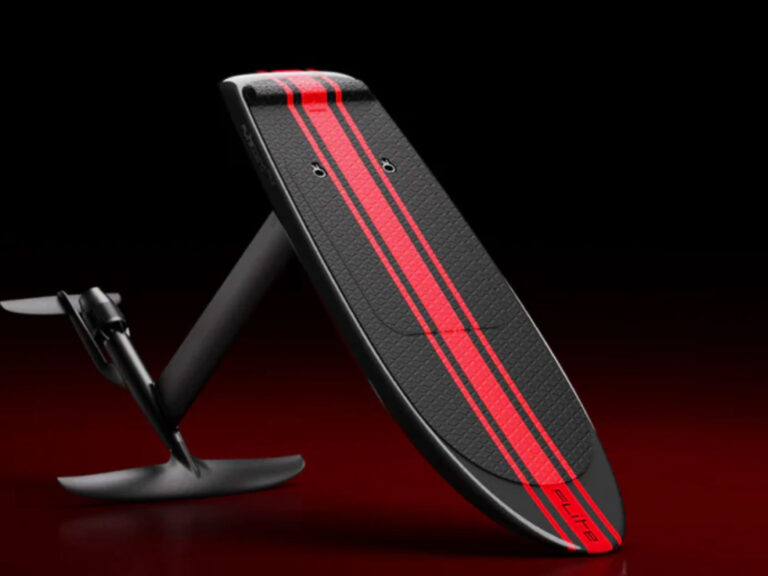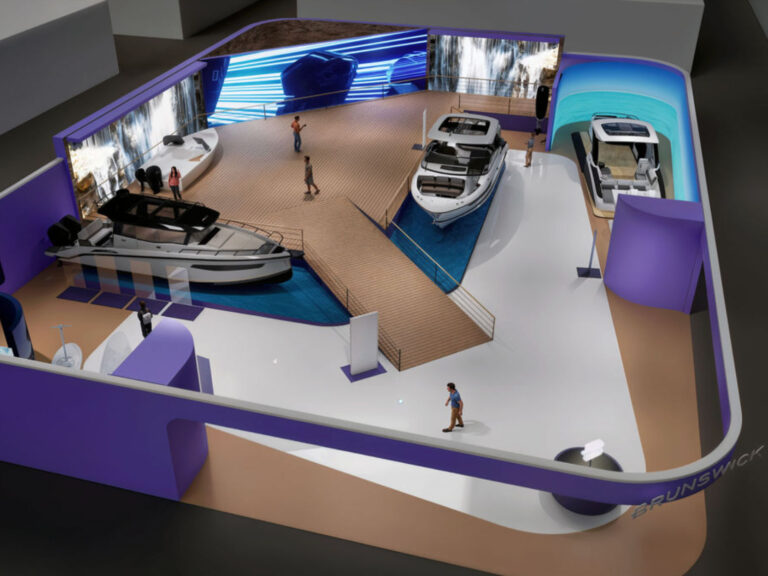How do you know whether premium binoculars are worth the money? Optically, that’s a tough thing to determine. Sometimes the clearest elements of the choice come from brand equity, warranty and mechanical preferences. But we devised some tests to give you an experienced layman’s review.
Power
Optimum magnification for boats is considered to be 7x, or a magnification of seven. More powerful binoculars make it harder to focus on a moving target from a moving platform — your boat.
Objective Lens
This is the front or larger of the lenses. A 50mm objective lets in lots of light, valuable at dusk and dawn. In bright light, the distinctions between optic quality didn’t change dramatically from pricey to value-priced, but we could detect the difference on our eye-chart test.
Exit Pupil
A 7x binocular with a 50mm objective lens will have a 7.14 mm (50 divided by 7 equals 7.14) exit pupil. Theoretically, the larger the exit pupil, the brighter the image. But inferior optics could diminish the impact of a large exit pupil.
Field of View
A wide field of view is preferable when viewing moving targets from moving platforms. Field of view is measured as X feet at a range of Y. Typically, you’ll see FOVs of 300 to 400 feet at 1,000 yards.
Eye Relief
Eye relief is a measurement of how far from the eye the ocular can be held and still give a full image through the binoculars. This is especially important for users who wear corrective glasses.
Focus
Internally focused binoculars are more intuitive to use. The center knob adjusts the left eye, then adjust the focus ring on the right ocular (eye lens piece). Refocusing for different distances is done only with the knob. Binoculars for sports tend to have an ocular focus for each barrel, and once focused for, say, 100 yards, anything farther will be in focus.
Coatings
Anti-reflective coatings come in various chemical makeups. Some binoculars only coat the outer sides of the outer lenses. Fully multicoated binoculars have all lenses and prisms coated for optimum light transmission with minimal loss to reflection.
Prisms
Binocular lenses invert the image. Prisms are used to turn the image upright for the eye. Porro prisms use two prisms to turn the image 180 degrees. These larger prisms are optically ideal but require a wide shouldered binocular frame to house them. Roof prisms employ more and smaller prisms to invert the image, and these prisms are more compact, giving a smaller, linear look to the binocular barrels. The best prisms are of BAK4 glass; lesser prisms are of BK7.
Testing
We used Snellen eye charts at 25 yards, one in dim light and one in brighter light. Outdoors we used one Snellen eye chart at 100 yards in bright light and noted how many lines on the chart we could read.

Cabela’s Fathom 7×50 Model IK-714722
In the Box: The box is a watertight hard case, and inside is a padded neck strap and lens caps, plus a cleaning cloth.
Conclusions: In bright daylight, these binoculars provided a clear view and are easy to focus. Once focused, the depth of focus was fairly generous, but refocusing from 100 yards to 20 yards had to be done one ocular at a time. At 25 yards, most testers could nearly read the entire bottom line on a Snellen eye chart in both bright and dim light. At 100 yards we could clearly read to the third line from the smallest. The binoculars are the heaviest we tested, which initially provided stability, but fatigue set in sooner, destabilizing the image.
Price: $399.99
Available: cabelas.com
Warranty: Unavailable (at press time)
Power: 7
Objective: 50mm
Exit Pupil: 7.14 mm
Eye Relief: 23 mm
Field of View: 393 ft.
Focus Style: Individual eyepiece
Prism Style: Porro with BAK4 multicoated glass
Rubber Armored: Yes
Length: 7.5 in.
Width: 8.75 in.
Height: 3.5 in.
Weight: 57.14 oz.
Coatings: Fully multicoated lenses
Waterproof: IPX7
Nitrogen Filled: Yes
O-ring Sealed: Yes

West Marine Coastal 400 Model 18407650
In the Box: The ballistic nylon carry case includes a padded neck strap and lens caps and a lens cleaning cloth.
Conclusions: These let us read the chart at line 8, second from the bottom, in both dim and moderate light. They excelled in sunlight but, as expected, weren’t as bright as the pricier models. In our 100-yard test they could read line 6, fourth from the bottom, consistently. We prefer their internal focus to separately focused oculars because changes from one range to another were quick, as tested by switching from 25- to 12-yard targets.
Price: $299.99
Available: westmarine.com
Warranty: Limited lifetime
Power: 7
Objective: 50mm
Exit Pupil: 7.14 mm
Eye Relief: 19.5 mm
Field of View: 410 ft.
Focus Style: Internal center focus with right-eye adjustment to equalize strength
Prism Style: Porro with BAK4
Rubber Armored: Yes
Length: 7 in.
Width: 7.75 in.
Height: 3 in.
Weight: 29 oz.
Coatings: Unknown
Waterproof: IPX7
Nitrogen Filled: Yes
O-ring Sealed: Yes

Bushnell Marine Binoculars Model 137500
In the Box: The nylon case includes a neck strap and second strap for the binoculars, as well as lens covers and manuals.
Conclusions: We were surprised at their clarity considering the price. The compass was illuminated by natural and electric light and easy to read in the left barrel. At 25 yards in bright light all testers could read half the letters on the bottom line of the eye chart, and in dim light half the testers could read half the bottom line. At 100 yards, the Bushnells could resolve line 6 but did not provide enough clarity to read lines 7, 8 or 9. The separate ocular focusing was slower, but targets over 100 yards were all in focus once adjusted for each eye’s strength.
Price: $255
Available: bushnell.com
Warranty: Limited lifetime
Power: 7
Objective: 50mm
Exit Pupil: 7.14 mm
Eye Relief: 18 mm
Field of View: 367 ft.
Focus Style: Individual eyepieces
Prism Style: Porro with BAK4 uncoated
Rubber Armored: Yes
Length: 7 in.
Width: 8 in.
Height: 3 in.
Weight: 37 oz.
Coatings: Some fully multicoated lenses
Waterproof: Yes (IPX unspecified)
Nitrogen Filled: Unspecified
O-ring Sealed: Yes

Steiner Navigator Pro 7X50C Model 7155
In the Box: The nylon padded case includes a neck strap, lens covers and neoprene neck strap for the binos.
Conclusions: These got a “Wow!” from one tester the instant she raised them to her eyes. Once the separate oculars were focused, all testers could read the smallest letters on the bottom of the eye chart at 25 yards. In bright light the optics were clear, and the image was sharp at 100 yards. Perhaps a testament to the larger exit pupil and objective lens, the 7-power Steiners were capable of resolving line 7 of the Snellen chart. The compass is naturally and electrically illuminated, steady and easy to read. Even at their price point, they are a bargain for their optical quality and come with the most extreme waterproof rating of those we tested.
Price: $689.99
Available: steiner-optics.com
Warranty: Lifetime transferrable
Power: 7
Objective: 50mm
Exit Pupil: 7.14 mm
Eye Relief: 20.2 mm
Field of View: 370 ft.
Focus Style: Sports auto focus
Prism Style: Porro
Rubber Armored: Yes
Length: 5.5 in.
Width: 8.1 in.
Height: 3.5 in.
Weight: 39.6 oz.
Coatings: Fully multicoated
Waterproof: IPX8 to 16 feet
Nitrogen Filled: Pressurized to 14 psi
O-ring Sealed: Yes

Pentax Z-Series 8×43 Model ZD 8×43 ED
In the Box: Comes with neck strap and nylon padded carrying case with strap.
Conclusions: The higher magnification of the 8-power optics were still easy to use thanks to their compact construction. Glass optics transmitted light nearly as well as some 50mm objective binos and better than others. Testers could read most but not all of the very bottom line of the chart. The ZD binos at 8-power gave a clear view of line 7. The internal focus and right-eye ocular focus ring made adjustments easy. Instead of roll-down rubber eyecups, these eyecups ratcheted up or down for optimum eye relief with glasses.
Price: $859
Available: us.ricoh-imaging.com
Warranty: 25-year limited warranty
Power: 8
Objective: 43mm
Exit Pupil: 5.4 mm
Eye Relief: 22 mm
Field of View: 330 ft. or 6.3 degrees
Focus Style: Internal
Prism Style: Roof prism with BAK4
Rubber Armored: Yes
Length: 5.75 in.
Width: 4.875 in.
Height: 2.125 in.
Weight: 25.2 oz.
Coatings: Fully multicoated optics
Waterproof: JIS 6 to 3.3 ft.
Nitrogen Filled: Yes
O-ring Sealed: Yes

Pentax S-Series 8×42 Model SD 8×42 WP
In the Box: Comes with neck strap and nylon padded carrying case with strap.
Conclusions: It’s tough to understand the wide price disparity between the S- and Z-Series when the optical clarity in our test results were so similar. The ZD seems to have a more rugged “feel,” such as in the ratcheted eyecups. The S-Series appears to be rubber armored polymer rather than armored metal as on the Z. In the 25-yard tests, we could read most of the bottom line of the eye charts in bright and dim light, and half of our testers could read the whole bottom line in bright light. At 100 yards, the SD could read line 7 like the ZD, and we couldn’t detect an optical advantage to the more expensive Z-Series. The internal focus was quick to adjust, but the right-eye ocular focus ring below the main focus dial was awkward.
Price: $239
Available: us.ricoh-imaging.com
Warranty: 25-year limited warranty
Power: 8
Objective: 42mm
Exit Pupil: 5.3 mm
Eye Relief: 21 mm
Field of View: 7.5 degrees
Focus Style: Internal ocular
Prism Style: Roof prism
Rubber Armored: Yes
Length: 5.75 in.
Width: 4.875 in.
Height: 2.125 in.
Weight: 22.6 oz.
Coatings: Fully multicoated
Waterproof: JIS 6 to 3.3 ft.
Nitrogen Filled: Yes
O-ring Sealed: Yes

